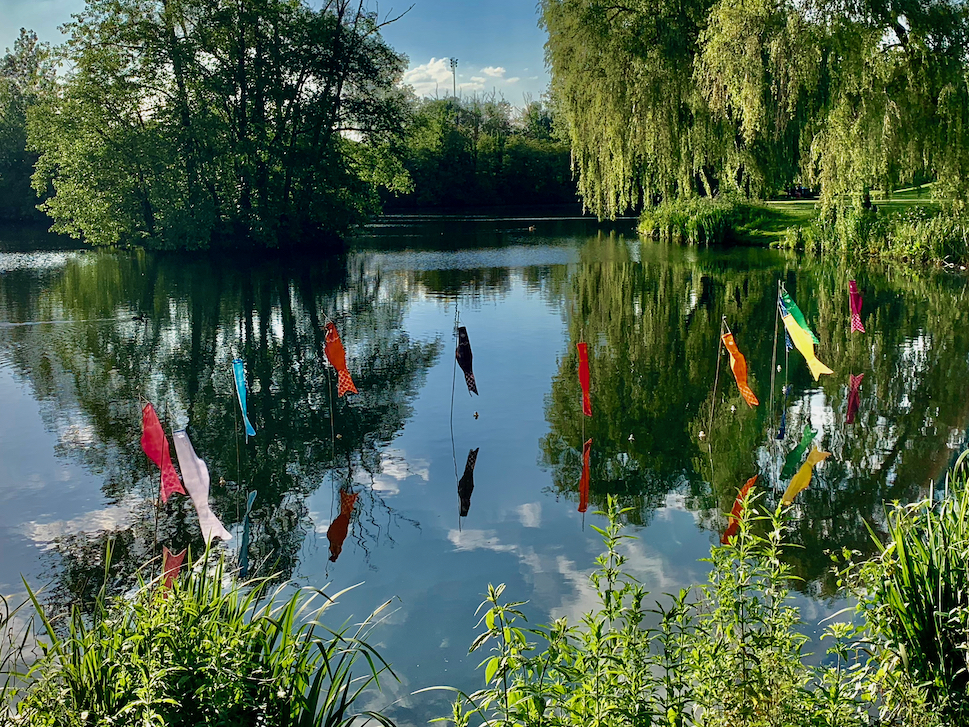The inspiration for A contre-courant came from koi carp-shaped windsocks. They are, by definition, the ideal accessory for withstanding different weather conditions. They are covered with a selection of photos, from Juste ciels, in the 11 colors of the LGBTQIA+ community’s inclusive rainbow, of which I am a proud member.
This playful and accessible project exudes a general feeling of zen; the carp being a peaceful and familiar animal, peaceful and gregarious, cohabiting without problems with other species of fish and therefore reputed to bring peace and serenity.
The main symbol of A contre-courant, the koi carp, in Japan, represents love. Indeed, the word “koi” in Japanese can mean both “carp” and “love”. In Chinese culture, they show the way to a life always in tune with reality, and are also a popular symbol of success and prosperity. Known to us mainly for their depictions in Japanese prints and paintings by the great masters who adore them, they also embody bravery, perseverance, determination, courage and strength, as they swim up rivers against the current. According to Chinese legend, the carp of the Yellow River, after swimming upstream, managed to reach the top of the waterfall, leap over it and fly skywards, transforming themselves into dragons. In Japan, this story is said to be the origin of koi-nobori (carp streamers), which represent the whole family swimming against the current, setting an example of courage for future generations.
The fable of the carp bravely swimming upstream resonates with me on a number of levels. Not least the fact that some of the principles of art are precisely to resist against all odds, to take the opposite tack, to experiment, to dare new experiences and not to be afraid of stepping out of one’s comfort zone. And, as I see it, one of the roles of artists is to educate audiences by shaking them up in their everyday lives. All these powerful symbols naturally led me to the representation of this shoal of multicoloured fish levitating in the middle of the water...
An accessible, colorful, moving, inclusive and positive image.
Installed as part of the Entre-Lacs Festival, Villeneuve d'Ascq, France, June & July 2024.

L’inspiration de A contre-courant vient des manches à air en forme de carpe koï. Elles sont par définition l’accessoire idéal pour résister face aux différentes conditions climatiques. Elles sont recouvertes d’une sélection de photos, provenant de Juste ciels, aux 11 couleurs de l’arc-en-ciel inclusif de la communauté LGBTQIA+ dont je fais fièrement partie.
Ce projet ludique et accessible dégage une sensation générale de zen; la carpe étant un animal paisible et familier, pacifique et grégaire cohabitant sans problèmes avec d’autres espèces de poissons et étant par conséquent réputé pour apporter la paix et la sérénité.
Symbole principal de A contre-courant, la carpe koï, au Japon, représente l’amour. En effet, le mot “koï” en japonais peut signifier à la fois “carpe” et “amour”.
Dans la culture chinoise, elle montre la voie à suivre pour vivre toujours en phase avec la réalité et est également un symbole populaire de succès et de prospérité.
Connues chez nous principalement pour leurs représentations sur les estampes et les peintures japonaises des grands maîtres qui les adulent, elles incarnent aussi la bravoure, la persévérance, la détermination, le courage et la force, du fait qu’elles remontent les rivières à contre-courant. Selon la légende chinoise, les carpes du Fleuve Jaune, après avoir remonté celui-ci, ont réussi à atteindre le sommet de la cascade, sauter par-dessus celle-ci et s’envoler vers le ciel en se transformant en dragons. Cette histoire serait à l’origine au Japon des koi-nobori (banderole de carpe) qui représentent toute la famille nageant à contre-courant, insufflant un exemple de courage aux futures générations..
La fable des carpes remontant courageusement le fleuve résonne en moi sur différents points. Notamment sur le fait que certains des principes de l’art sont justement de résister contre vents et marée, prendre le contre-pied, expérimenter, oser de nouvelles expériences et ne pas avoir peur de sortir de sa zone de confort. Et, selon moi, un des rôles des artistes est d’éduquer les publics en les bousculant dans leur quotidien. Tous ces puissants symboles m’ont ainsi naturellement guidé vers la représentation de ce banc de poissons multicolores en lévitation au milieu de l’eau. Une image accessible, colorée, en mouvement, inclusive et positive.
Installé dans le cadre du Festival Entre-Lacs, Villeneuve d'Ascq, France, en juin et juillet 2024.
